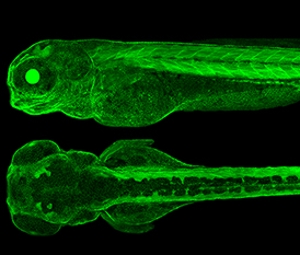Research project
ZF-HEALTH - Zebrafish Regulomics for Human Health
How can zebrafish research help understanding human diseases?
- Duration
- 2010 - 2016
- Contact
- Herman Spaink
- Funding
-
 European Commission 7th framework programme Grant Agreement HEALTH-F4-2010-242048
European Commission 7th framework programme Grant Agreement HEALTH-F4-2010-242048
- Partners
Karlsruher Institut für Technologie (KIT-G)
And several other partners.

ZF-HEALTH is a Large-scale Integrating Project funded by the European Commission that aims to exploit the advantages of the zebrafish as a model organism for vertebrate development and human disease.
The zebrafish is recognized as one of the primary model organisms for biomedical research. European funding for the projects ZF-MODELS (2004-2008) and ZF-HEALTH (2010-2016) has enforced collaboration between researchers in this field. In ZF-MODELS, new disease models, large-scale mutant resources, and many fluorescent reporter lines labelling cells, tissues and organs, were developed and shared with the worldwide zebrafish community. Building on the results of this successful project, ZF-HEALTH aims at the high-throughput phenotyping of at least a thousand regulatory genes relevant for human disease.
To achieve this goal, ZF-HEALTH takes a systems biology approach that includes behavioural characterisation of mutant fish lines, 3D / 4D imaging, gene expression profiling by deep sequencing, and study of the regulators of gene expression. Another important goal is to identify new drug candidates by screening for small-molecule effects on mutant phenotypes or disease-relevant processes. The groups of Herman Spaink, Annemarie Meijer, Ewa Snaar and Marcel Schaaf at the Institute of Biology, participating both in ZF-MODELS and ZF-HEALTH, focus on genes of the innate immune system associated with inflammatory and infectious diseases (tuberculosis), diabetes, and cancer.
- Yang S, Marín-Juez R, Meijer AH, Spaink HP (2015) Common and specific downstream signaling targets controlled by Tlr2 and Tlr5 innate immune signaling in zebrafish. BMC Genomics 16: 547
- Veneman WJ, de Sonneville j, van der Kolk KJ, Ordas A, Al-Ars Z, Meijer AH, Spaink HP (2015) Analysis of RNAseq datasets from a comparative infectious disease zebrafish model using GeneTiles bioinformatics. Immunogenetics 67:135-47
- Hosseini R, Lamers GE, Hodzic Z, Meijer AH, Schaaf MJ, Spaink HP. (2014) Correlative light and electron microscopy imaging of autophagy in a zebrafish infection model. Autophagy 10:1844-57
- Ordas A, Raterink RJ, Jansen HJ, Cunningham F, Wiweger MI, Jong-Raadsen S, Bates RH, Barros D, Meijer AH, Vreeken RJ, Ballell-Pages L, Dirks RP, Hankemeier T, Spaink HP. (2014) Testing tuberculosis drug efficacy in a zebrafish high-throughput translational medicine screen. Antimicrob Agents Chemother 59: 753-62
- van der Vaart M, van Soest JJ, Spaink HP, Meijer AH (2013) Functional analysis of a zebrafish myd88 mutant identifies key transcriptional components of the innate immune system. Disease Models and Mechanisms 6:841-54
- Zhao J, Lambert G, Meijer AH, Rosa FM (2013) The Vox transcription factor represses endoderm development by interacting with Casanova and Pou2/Pou5f1/0ct3/Oct4. Development 140: 1090-1099
